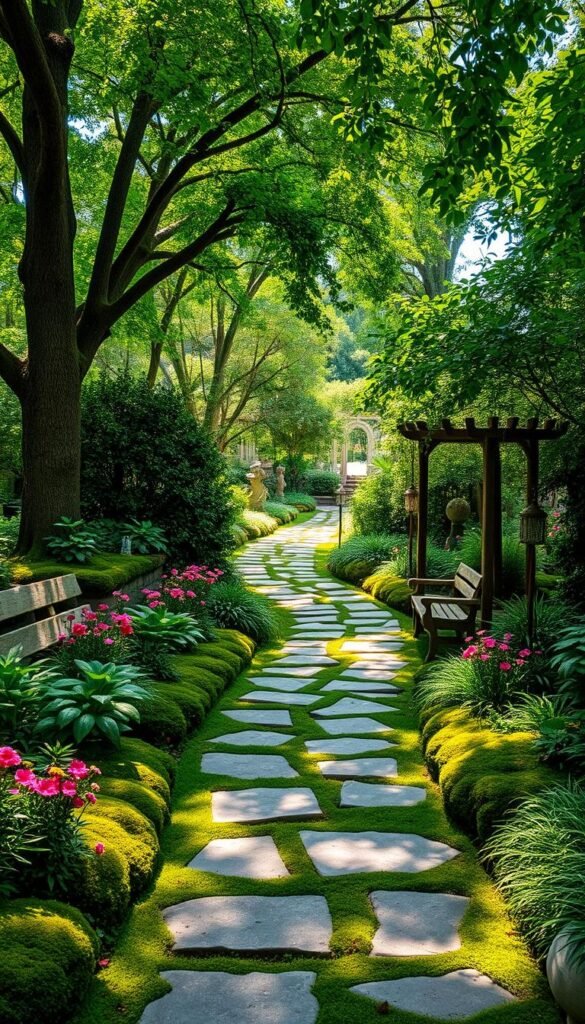Imagine stepping into an outdoor space where every stroll feels intentional and inviting. Thoughtfully designed pathways do more than connect point A to B—they shape how you experience your yard. These winding or straight routes act as visual guides, turning a simple walk into a journey through your personal oasis.
A well-planned path isn’t just practical—it’s a design element that elevates your property’s appeal. It creates natural boundaries between flower beds and seating areas while ensuring easy access for maintenance. The right materials and layout can make your outdoor space feel cohesive, blending your home’s architecture with nature’s beauty.
You’ll discover how these functional features can solve common landscape challenges. From preventing muddy footprints to highlighting your favorite plants, pathways add structure without sacrificing style. They’re the secret to making large yards feel intimate and small spaces appear expansive.
Ready to transform how people move through your property? Let’s explore how clever path designs create flow, improve safety, and turn everyday walks into memorable experiences. Your landscape deserves more than just utility—it deserves character.
Setting the Stage: Evaluating Your Garden and Path Needs
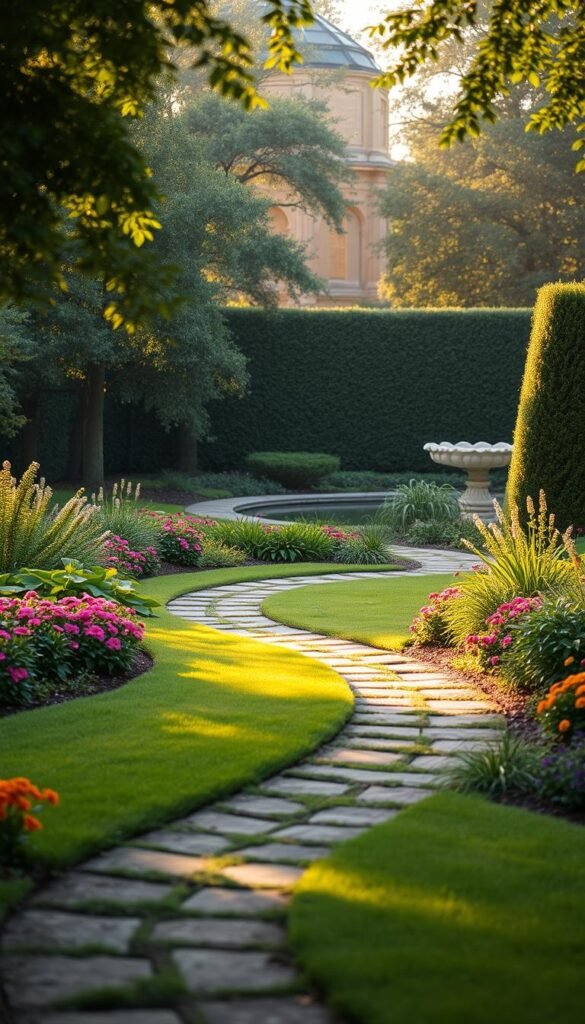
Your outdoor space tells a story through its natural features and daily use patterns. Start by mapping your property’s unique personality—measure slopes, note sunlight patterns, and test soil drainage. These elements determine whether materials like gravel or pavers will thrive in different yard areas.
Assessing Your Property’s Blueprint
Walk your land with fresh eyes. Identify existing routes where grass wears thin—these natural trails reveal where paths should logically flow. Sketch zones needing connection: vegetable patches to kitchens, patios to flower beds. Remember—steep slopes may need switchbacks, while flat spaces allow creative curves.
Defining Pathway Priorities
Ask yourself: Is this route for quick trash can access or sunset strolls? Straight-line designs work best for functional trips, while meandering walkways encourage exploration of your plantings. Multi-purpose solutions might combine stepping stones for foot traffic with wider gravel sections for wheelbarrows.
Consider future growth—leave space for expanding gardens or adding benches. Your plan should balance today’s needs with tomorrow’s possibilities, creating routes that feel intentional yet adaptable.
Understanding the Role of Garden Paths in Landscape Design
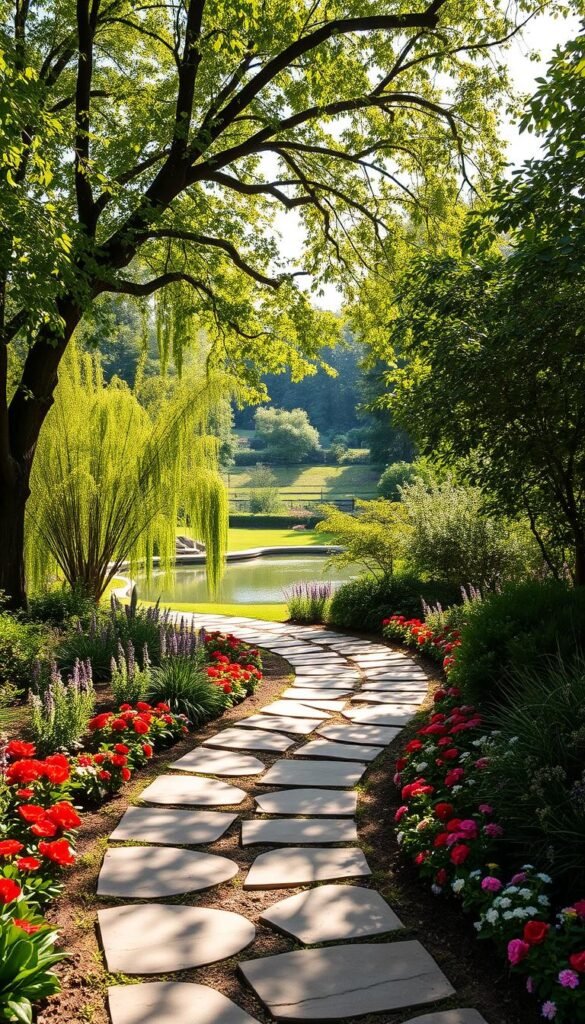
Your outdoor space becomes more than just plants and soil when pathways guide the experience. These routes act as both practical tools and artistic elements, shaping how you interact with nature. A well-designed walkway doesn’t just get you from place to place—it invites curiosity and frames your view of the surroundings.
Enhancing Curb Appeal and Functionality
Strategic path placement makes your property look intentional. Straight lines suggest efficiency, while curves create mystery. Materials matter too—crushed stone whispers casual charm, while flagstone shouts polished elegance. Pair these choices with whimsical plantings for a storybook feel.
Durability plays a key role. High-traffic zones need sturdy surfaces like concrete or brick. Quieter routes can use mulch or grass pavers. Every material choice balances beauty with practicality.
Creating Seamless Transitions Between Outdoor Areas
Paths act as connectors, turning separate zones into a unified whole. Use matching edging plants along a gravel trail to blend your vegetable patch with the patio. A boardwalk through wetland areas protects delicate ecosystems while providing access.
Width variations signal purpose. Narrow trails encourage single-file exploration, while broader walkways welcome group strolls. Clever design tricks, like gradually widening paths near seating nooks, make transitions feel natural.
Creative Approaches: 8 Garden Path Ideas for Leading Visitors Through Your Landscape
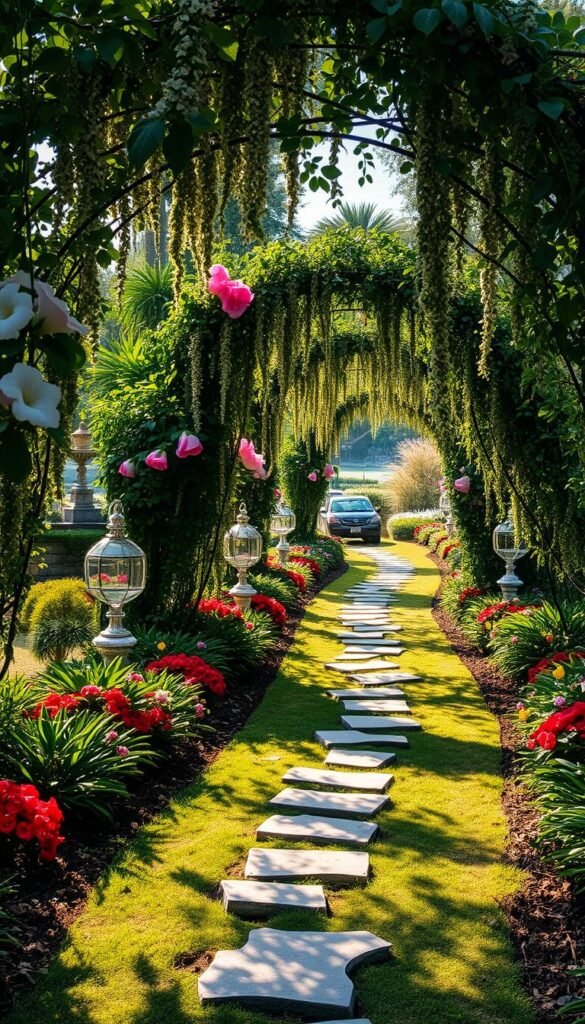
Crafting pathways that blend function with artistic expression elevates any yard. Whether you prefer clean geometric lines or organic shapes that mimic nature, your choice in design sets the tone for outdoor adventures. Let’s dive into styles that turn ordinary routes into memorable journeys.
Structured walkways bring sophistication with materials like cut stone or brick. These polished options work beautifully near modern homes, creating crisp borders for flower beds. For a playful twist, try alternating paver colors to form subtle patterns underfoot.
Meandering trails invite curiosity when lined with aromatic herbs or wildflowers. Use irregular flagstones surrounded by creeping thyme to soften edges naturally. This approach feels especially magical in woodland settings, where dappled sunlight enhances the pathway’s charm.
Budget-conscious ideas shine too—try decomposed granite between timber sleepers for rustic appeal. Urban spaces benefit from vertical planters alongside narrow stepping stones, maximizing greenery without sacrificing walk space. Each solution adapts to your terrain while guiding movement purposefully.
Mix materials strategically for visual texture. Combine smooth river rocks with rough-hewn wood slices near water features. These contrasts slow foot traffic, encouraging guests to appreciate surrounding blooms. Remember: your garden path ideas should reflect both practicality and personality.
From moonlight-friendly gravel to child-safe mulch surfaces, every design choice tells a story. What will yours say?
Choosing the Right Materials for Your Pathway
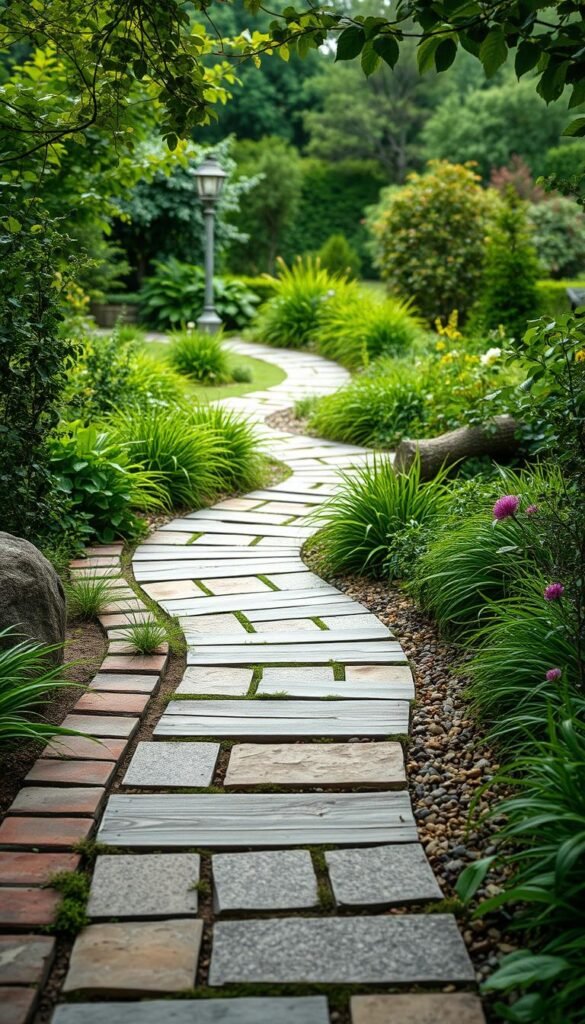
Your pathway materials set the tone for outdoor journeys while standing up to weather and foot traffic. Each option brings unique textures and durability levels—from rustic charm to polished elegance. Let’s break down popular choices and smart strategies for matching surfaces to your vision.
Natural Stone, Brick, Gravel, and More
Flagstone and slate create timeless elegance, perfect for formal settings. Irregular shapes add organic appeal, while cut pavers deliver clean lines. Brick walkways offer classic warmth but need proper drainage to prevent frost damage in colder zones.
Gravel provides casual charm and excellent drainage at lower costs. Pair it with metal edging to contain loose stones. For modern spaces, concrete slabs or stamped patterns mimic pricier materials. Check local suppliers for discounted remnants or overstock deals.
| Material | Cost (per sq.ft) | Durability | Best For |
|---|---|---|---|
| Flagstone | $15-$30 | 30+ years | Formal areas |
| Brick | $8-$12 | 25 years | Traditional designs |
| Gravel | $1-$3 | 5-10 years | Cottage gardens |
| Concrete | $6-$10 | 20+ years | Modern landscapes |
| Mulch | $0.50-$2 | 2-3 years | Woodland trails |
Budget-Friendly Options and Durability Considerations
Reclaimed bricks or salvaged pavers cut costs by 40-60%. Many landscaping companies offer free wood chips or bark to avoid disposal fees—perfect for casual trails. For high-traffic zones, consider crushed granite—it compacts better than round gravel.
When browsing walkway ideas, prioritize materials that handle your climate. Mortared stone withstands freeze-thaw cycles better than loose materials. In hot regions, light-colored concrete stays cooler underfoot than dark pavers.
Incorporating Plants and Greenery Along Your Walkway
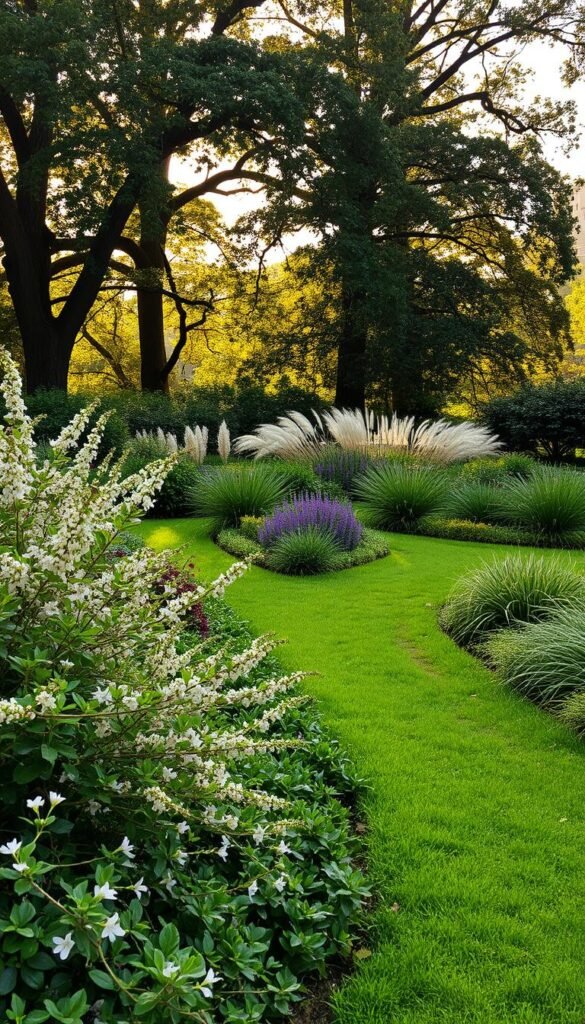
Transform your walkways into living borders that engage the senses. Strategic planting softens hard edges while adding movement and color. These green companions frame your path like nature’s own decorators.
Selecting Hardy Ground Covers and Edging Plants
Choose low-growing varieties that thrive with foot traffic. Bugleweed’s purple spikes and lamb’s ears’ velvety leaves create tactile interest. Creeping phlox forms evergreen carpets that bloom in spring.
For formal settings, boxwood hedges define clean lines. Annuals like sweet alyssum spill over pavers with honey-scented flowers. Dwarf zinnias add bold hues without blocking views.
Complementary Planting Ideas to Soften Hardscapes
Space stones wider to let thyme or chamomile fill gaps. These fragrant ground covers release scent when brushed. In shaded areas, hostas and sedges thrive between stepping stones.
| Plant Type | Height | Sun Needs | Key Feature |
|---|---|---|---|
| Creeping Thyme | 2-3″ | Full sun | Drought-resistant |
| Lady’s Mantle | 12-18″ | Partial shade | Water-beaded leaves |
| Lavender | 18-24″ | Full sun | Deer-resistant |
| Scottish Moss | 1-2″ | Shade | Velvety texture |
Mix perennials like lavender for year-round structure. Their gray-green foliage contrasts beautifully with stone or gravel. Add seasonal pops with wax begonias—their glossy leaves reflect moonlight.
These living accents do more than beautify. They stabilize soil, support pollinators, and guide visitors naturally. Your path becomes part of the garden itself.
Designing for Different Traffic Levels and Safety
Every route in your yard serves a unique purpose. Some need to handle daily foot traffic, while others exist for quiet moments. Matching materials to each path’s role keeps surfaces safe and reduces wear over time.
Smart Surface Selection
Main walkways deserve tough materials like concrete or granite. These handle heavy use and winter maintenance without cracking. For entry paths, textured pavers add grip even when wet.
| Material | Best Use | Maintenance | Safety Notes |
|---|---|---|---|
| Concrete | Front entrances | Low | Resists ice damage |
| Flagstone | Pool areas | Moderate | Natural non-slip surface |
| Pea Gravel | Side trails | High | Needs edging |
| Mulch | Garden loops | Seasonal | Soft for falls |
Secondary walkways benefit from softer options. Wood chips blend into natural settings, while decomposed granite stays put on gentle slopes. Avoid smooth bricks near water features—they become slick quickly.
Install steps with overhangs to prevent tripping. Space lights every 6-8 feet for nighttime visibility. For steep areas, railings add support without blocking views. These choices make every way through your space both practical and inviting.
Mix functional materials with creative gardening ideas to balance durability with style. Your routes will guide feet safely while complementing your landscape’s personality.
Forming Focal Points and Destination Elements
Transform your walkways into discovery zones that reward exploration. Strategic placements turn ordinary routes into engaging journeys, giving visitors reasons to pause and admire your space. A well-positioned feature becomes both a visual target and a resting spot.
Guiding Eyes With Purposeful Features
Anchor your path’s end with striking elements like stone urns or metal sculptures. These markers create natural stopping points while framing views of flower beds. Place seating halfway along winding trails—wooden benches under trees invite quiet reflection.
Water elements work wonders for sensory appeal. A small fountain near the journey’s end adds soothing sounds, while strategic lighting highlights ripples after dark. For classic charm, try tiered birdbaths surrounded by lavender.
Balance scale carefully. Oversized statues might overwhelm narrow paths, while tiny ornaments get lost in expansive yards. Match your focal points to the path’s width and your home’s architecture for harmony. Every feature should feel intentional, not accidental.
Mixing Multiple Textures and Materials for Visual Interest
Layering different surfaces underfoot creates a sensory journey through your landscape. Mixing textures adds depth while guiding eyes—and feet—toward key features. This approach turns functional routes into artistic statements that evolve with each step.
Combining Pavers, Pebbles, and Natural Elements
Pair rectangular pavers with loose pebbles for contrast that catches the eye. Stepping stones nestled in bark mulch give woodland trails organic charm. Edging grassy strips with brick creates crisp lines that frame lush greenery.
Shift materials where zones change. A gravel section might lead to a dining patio, while flagstone marks entry to flower beds. This subtle signaling helps visitors navigate without signs.
Try a checkerboard pattern with alternating stones and plants. Fill gaps with fragrant ground covers like Corsican mint—their tiny leaves release scent when brushed. Scottish moss thrives in shady spots, softening edges with velvety texture.
These layered looks spark interest while solving practical needs. Rough surfaces prevent slips, while smooth stones feel luxurious under bare feet. Every combination tells its own story, making your landscape unforgettable.

